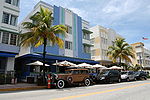World Erotic Art Museum
2005 establishments in FloridaArt museums and galleries in FloridaArt museums established in 2005Museums in Miami Beach, FloridaSex museums in the United States ... and 1 more
Sexuality in Florida

The World Erotic Art Museum, located in the heart of the Miami Beach, Florida Art Deco District, is a museum, library, and education think tank that uses its collection to illustrate the history of erotic art. It contains the collection of Naomi Wilzig.
Excerpt from the Wikipedia article World Erotic Art Museum (License: CC BY-SA 3.0, Authors, Images).World Erotic Art Museum
Washington Avenue, Miami Beach
Geographical coordinates (GPS) Address Phone number Website External links Nearby Places Show on map
Geographical coordinates (GPS)
| Latitude | Longitude |
|---|---|
| N 25.783295 ° | E -80.132102 ° |
Address
World Erotic Art Museum
Washington Avenue 1205
33139 Miami Beach
Florida, United States
Open on Google Maps










